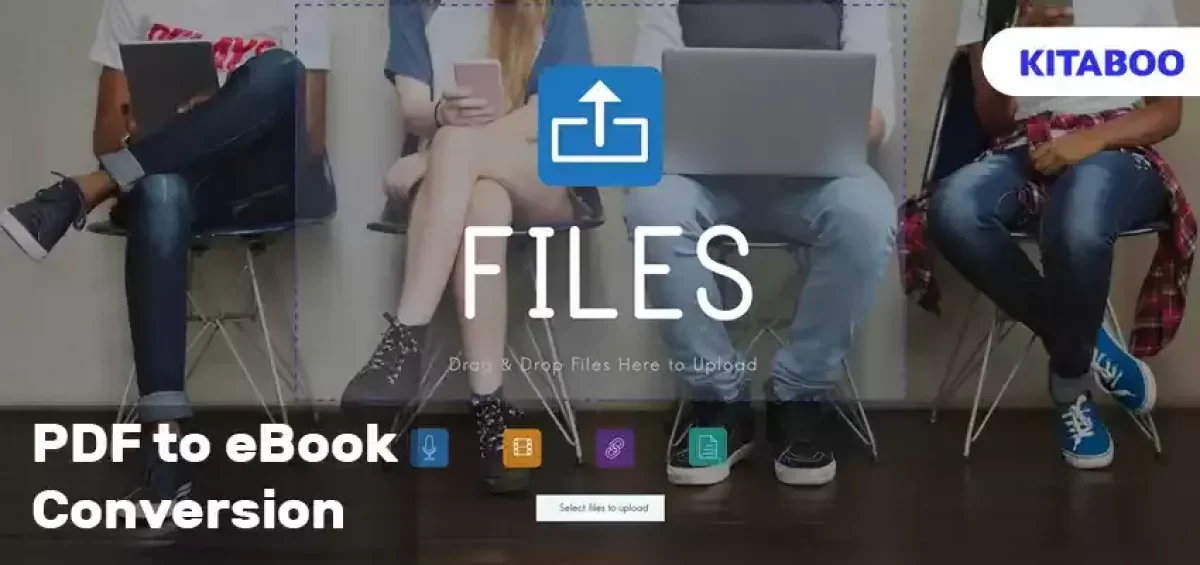Did you know that the global number of eBook users is projected to rise steadily from 2024 to 2027? If you’re an author contemplating when to make the shift to eBooks, the answer is clear—the time is now! The eBook industry has experienced remarkable growth in recent years, with forecasts indicating that the eBook market size will soar to US$ 32.19 billion by 2032.
The reason for this popularity is due to their easy access, portability, and space-saving nature. Apart from this, eBooks are customizable, environmentally friendly, cost-effective, and shareable.
This blog will serve as a guide that explains the importance of converting PDFs into eBooks for authors, techniques for conversion, and provide a step-by-step guide to convert PDFs to eBooks. Additionally, we will cover the future of eBooks for authors.
Let’s get exploring!
Table of Contents:
I. The Importance of Converting PDFs to eBooks for Authors
II. Exploring the Tools for PDF to eBook Conversion
III. Step-by-Step Guide: How to Convert PDF to eBooks?
- Understand the Significance of eBook Formats
- Assess Your PDF Content for Conversion
- Explore Online Conversion Tools
- Opt for Downloadable Conversion Software
- Upload the PDF
- Customize the eBook
- Convert and Download
IV. Conclusion
The Importance of Converting PDFs to eBooks for Authors
While the traditional way is fantastic, it’s essential to adapt to trends as well, such as interactive eBooks. The readers demand something that can keep them hooked to the end. And, as attention spans are decreasing daily, what could be better than an eBook? So here are some of the benefits of converting PDFs to eBooks that authors should look at:
- Ebooks are widely accessible due to their compatibility across various devices and platforms, reaching a much larger audience than printed books alone. This can open doors to international readers and diverse demographics.
- It often has higher royalty rates compared to traditional publishing, allowing authors to keep a larger share of their profits.
- Sell your eBook through various online retailers like Amazon, Kobo, Google Play Books, and independent stores, boosting visibility and sales potential.
- Integrate multimedia elements like images, videos, audio snippets, and even quizzes into your eBook, offering a more engaging and immersive reading experience.
Exploring the Tools for PDF-to-eBook Conversion
Converting a PDF into an eBook is a hassle, but with some tools, it can be easier to follow the process and save time. Here are some tools to explore:
KITABOO
KITABOO is an interactive eBook creator and a cloud-based digital publishing platform. It allows authors to create and publish DRM-protected content, supporting various features such as images, videos, audio, and read-aloud functionality. KITABOO also offers support in 25 languages, ePub conversion, user analytics, and secure online book distribution.
Calibri
Calibri is an open-source program to manage eBooks. It supports multiple formats, such as ePub, FB2, and MOBI, and can be an excellent free PDF to ePub converter. It offers batch conversion, preserves formatting, hyperlinks, and image quality, and allows you to select pages to convert and customize the output location.
Zamzar
Zamzar is a popular online tool for converting PDF to ePubs. It doesn’t allow extensive customization, but it retains the format of the original PDF files in the converted ePub eBook.
Step-by-Step Guide: How to Convert PDF to eBooks?
Converting PDFs into engaging eBooks offers enhanced readability and compatibility with diverse eReading devices.
Follow the steps mentioned below to transform your PDFs into captivating eBooks:
1. Understand the Significance of eBook Formats
Authors looking to publish their eBooks must first understand the significance of various eBook formats. Notably, PDF, ePub, MOBI, and other formats are compatible with distinct devices such as eReaders, tablets, and smartphones. Choosing the appropriate format aligns with the targeted audience and enhances the overall reading experience.
2. Assess Your PDF Content for Conversion
Before starting the conversion process, a thorough assessment of the PDF content is essential. Planning becomes the foundation of a successful eBook conversion.
Authors need to identify interactive elements and potential layout complications and consider the specific requirements of their audience, as careful planning sets the foundation for a seamless conversion experience.
3. Explore Online Conversion Tools
Online converters offer a viable solution for authors seeking a convenient and hassle-free conversion process. These tools are easily accessible, require no installation and facilitate a quick transition from PDF to eBook formats. However, it’s crucial to acknowledge the inherent limitations, such as limited customization options and potential challenges with complex layouts.
On a short note, KITABOO can provide a quick transition from PDF to popular eBook formats, eliminating the need for installation and complex software. This way, authors can seamlessly adapt their content for digital readers.
4. Opt for Downloadable Conversion Software
Authors who desire a faster and more customizable conversion experience may opt for downloadable conversion software. This approach provides a broader range of customization options and handles intricate layouts proficiently. However, technical expertise may be required to navigate advanced features effectively, as they involve software installation and may come with associated costs.
5. Upload the PDF
Once you’ve chosen the conversion tool, follow the tool-specific instructions to upload your PDF file. This is typically done by clicking the ‘Upload’ or ‘Choose File’ button and selecting the desired PDF from your device.
Choose the eBook format you want to convert the PDF into. The output format selection depends on the eReader or device you plan to use for reading the eBook. For example, if your readers use Kindle, you might choose the MOBI format, while an iPad might require the ePub format. So, be sure to align your format choice with the compatibility requirements of your intended reading devices.
6. Customize the eBook
Depending on your tool, you can customize the eBook. This can include editing the metadata, such as the title and author of the eBook. Authors can customize the look and feel of the eBook by adjusting the font, layout, and color scheme.
7. Convert and Download
After customizing the eBook, do the following:
- Initiate the conversion process.
- Once the conversion is complete, download the converted eBook file to your device or computer.
- Ensure that the downloaded file is compatible with your eReader or reading app.
It’s essential to consider the complexity of the original PDF, as complex layouts and designs may translate poorly into an eBook format. Additionally, consider the reading experience and the features you want to include in the eBook, such as interactive elements, before starting the conversion process.
Conclusion
Converting PDFs to eBooks expands accessibility, increases royalties, and offers multimedia integration. This step-by-step guide emphasizes planning, choosing the proper format, and utilizing online or downloadable conversion tools. By leveraging these essential techniques, authors can enhance their reach and engage readers effectively.
On that note, KITABOO is a cloud-based platform offering a range of services for authors, including the conversion of PDFs to eBooks. Authors can leverage KITABOO to convert PDF documents into eBooks, which can be distributed with DRM protection and accessed on multiple devices and platforms.
KITABOO also supports the integration of eBooks with learning management systems and provides real-time user metrics to measure learner engagement and content performance.
Write to us at KITABOO@hurix.com to learn more!
Discover How An Ebook Conversion, Publishing & Distribution Platform Can Help You
Kitaboo is a cloud-based content platform to create-publish & securely distribute interactive mobile-ready ebooks.
You May Also Like
-
Top K–12 Online Education Platforms in 2024
Blog,Digital Publishing,eBook solution / January 31, 2024








